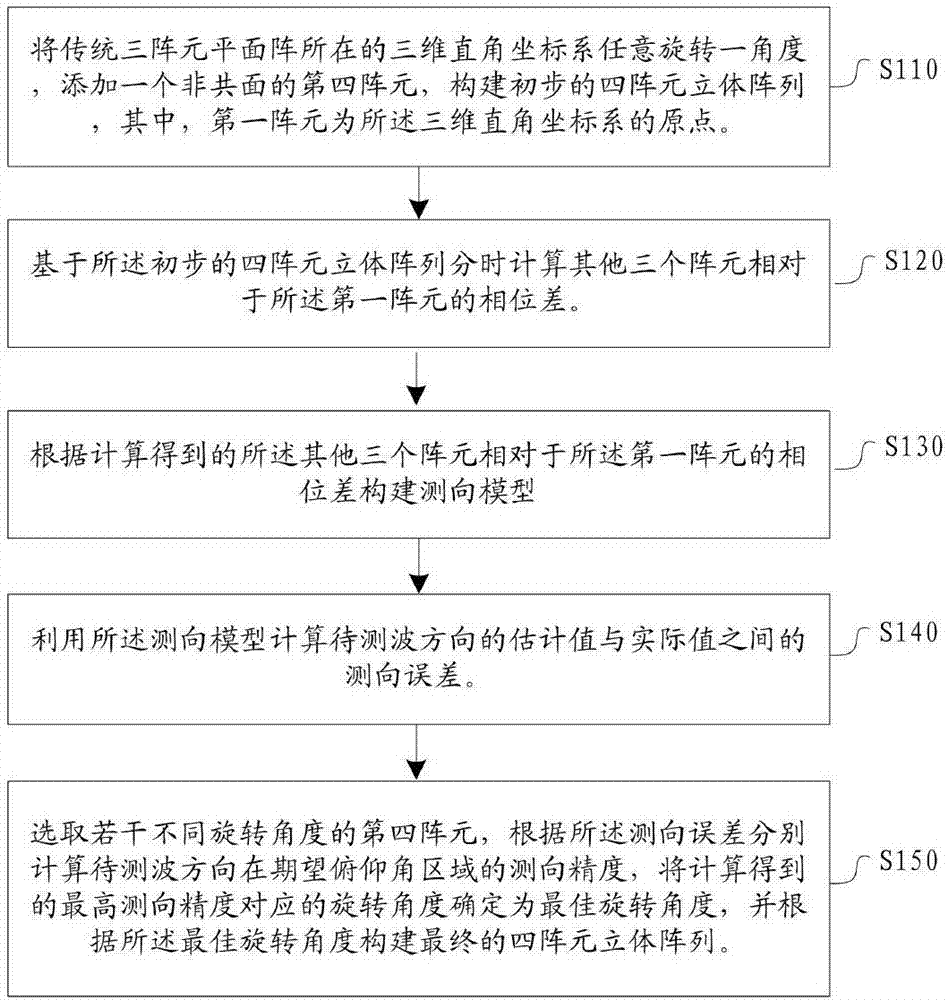Method and device for constructing four-element three-dimensional array
A three-dimensional array and four-array element technology, which is applied in the direction of measuring devices, orientators for determining directions, and direction finders using radio waves, etc., can solve the problem of low direction finding accuracy, improve direction finding accuracy, and save computing resources , to meet the effect of direction finding accuracy
- Summary
- Abstract
- Description
- Claims
- Application Information
AI Technical Summary
Problems solved by technology
Method used
Image
Examples
Embodiment 1
[0029] figure 1 It is a flowchart of a method for constructing a four-element three-dimensional array according to an embodiment of the present invention, such as figure 1 as shown,
[0030] In step S110, the three-dimensional Cartesian coordinate system in which the traditional three-element planar array is located is arbitrarily rotated by an angle, and a non-coplanar fourth array element is added to construct a preliminary four-element three-dimensional array, wherein the first array element is The origin of the 3D Cartesian coordinate system.
[0031] In step S120, phase differences of the other three array elements relative to the first array element are time-divisionally calculated based on the preliminary four-element stereo array.
[0032] In step S130, a direction finding model is constructed according to the calculated phase difference of the other three array elements relative to the first array element.
[0033] In step S140, the direction finding error between ...
Embodiment 2
[0092] image 3 It is a structural schematic diagram of a device for constructing a four-element three-dimensional array according to an embodiment of the present invention, such as image 3 As shown, the device 200 includes:
[0093] The three-dimensional array preliminary construction unit 210 is used to rotate the traditional three-element planar array by an angle, add a non-coplanar fourth array element, and construct a preliminary four-element three-dimensional array, wherein the first array element is the The origin of the three-dimensional Cartesian coordinate system;
[0094] The phase difference calculation unit 220 is configured to time-divisionally calculate the phase differences of the other three array elements relative to the first array element based on the preliminary four-element three-dimensional array.
[0095] A direction-finding model construction unit 230, configured to construct a direction-finding model according to the calculated phase difference of ...
Embodiment 3
[0117] In this embodiment, an implementation case of a low-orbit satellite four-element three-dimensional rectangular array is used to demonstrate its application steps and effects. In this implementation case, the phase difference time measurement system is adopted, and the channel phase difference measurement error is 10°. In practical applications, in addition to the high requirements for direction finding accuracy near the sub-satellite point (that is, near the pitch angle of 90°), there are also certain requirements for the direction finding accuracy in the area with a pitch angle of 35° to 50°. Figure 4 It is a schematic diagram of the direction-finding accuracy contour line of the four-element three-dimensional rectangular array when γ=45° according to an embodiment of the present invention; Figure 5 It is a schematic diagram of the direction-finding accuracy contour line of the four-element three-dimensional rectangular array when γ=60° according to an embodiment of ...
PUM
 Login to View More
Login to View More Abstract
Description
Claims
Application Information
 Login to View More
Login to View More - R&D
- Intellectual Property
- Life Sciences
- Materials
- Tech Scout
- Unparalleled Data Quality
- Higher Quality Content
- 60% Fewer Hallucinations
Browse by: Latest US Patents, China's latest patents, Technical Efficacy Thesaurus, Application Domain, Technology Topic, Popular Technical Reports.
© 2025 PatSnap. All rights reserved.Legal|Privacy policy|Modern Slavery Act Transparency Statement|Sitemap|About US| Contact US: help@patsnap.com



